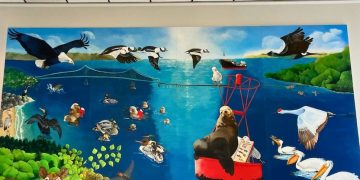Astoria, OR – In a significant display of collaboration, the Coquille Indian Tribe, along with local, county, and state agencies, participated in an emergency preparedness exercise earlier today. The event, which took place in Southwest Oregon, centered around the setup of an Evacuation Assembly Point (EAP), a key component in the region’s disaster response plan.
An EAP is a designated area where individuals can gather during and after emergencies, such as a Cascadia earthquake and tsunami. These points are critical for managing evacuations, providing immediate shelter, and ensuring that necessary supplies are distributed until emergency responders can access more heavily impacted areas.
The equipment used to create the EAP was purchased by the Oregon Department of Human Services’ Office of Resilience and Emergency Management (OREM). In a show of solidarity and readiness, the Coquille Indian Tribe has agreed to house this equipment on their land. The supplies, stored in metal shipping containers, include food, water, tents, and medical provisions, enough to support up to 100 people for up to two weeks.
Tribal leaders expressed their enthusiasm for the exercise and the responsibility they have taken on in supporting their community. “The Coquille Indian Tribe is excited to be able to take on this responsibility, which highlights what is possible when two sovereign entities work together for the common good,” said Brenda Meade, Chair of the Coquille Indian Tribe. “This partnership is a great example of our commitment to the community and emphasizes the importance of ensuring we are prepared to support both our Tribal citizens and neighboring residents during a crisis.”
This particular EAP is the third to be deployed along the Oregon Coast, with additional sites established at the Tillamook Municipal Airport and the Newport Airport. These locations are critical, as data suggests that coastal communities are at high risk of being cut off from the rest of the state in the aftermath of a Cascadia earthquake, making quick access to supplies and evacuation points essential.
Ed Flick, Director of the Oregon Office of Resilience and Emergency Management, acknowledged the importance of these partnerships in preparing for potential natural disasters. “Coastal communities are a priority for housing EAP equipment because they are most likely to be isolated following a major seismic event,” Flick said. “I’m grateful to the Coquille Indian Tribe for hosting this exercise and for their willingness to stage this vital equipment for the benefit of both Tribal members and their neighbors.”
This exercise underscores the value of community preparedness and cooperation, particularly as the region faces the ongoing threat of a major earthquake and tsunami event. With support from the Coquille Indian Tribe and other local partners, Oregon continues to strengthen its disaster readiness and resilience, ensuring that critical resources are readily available when disaster strikes.














